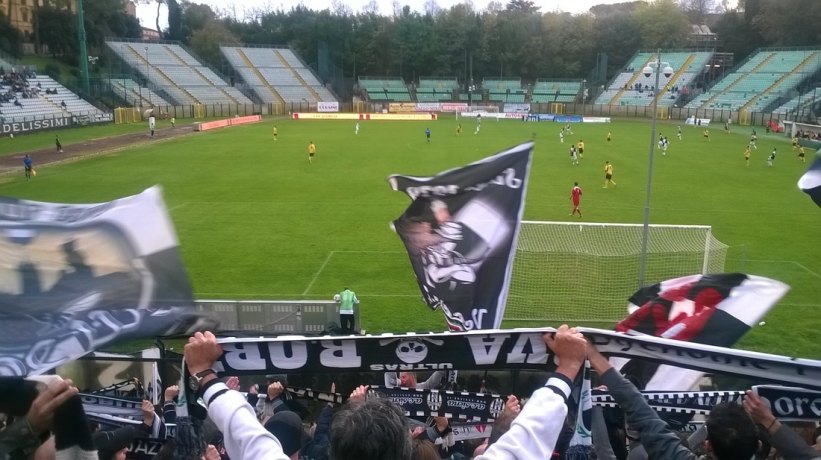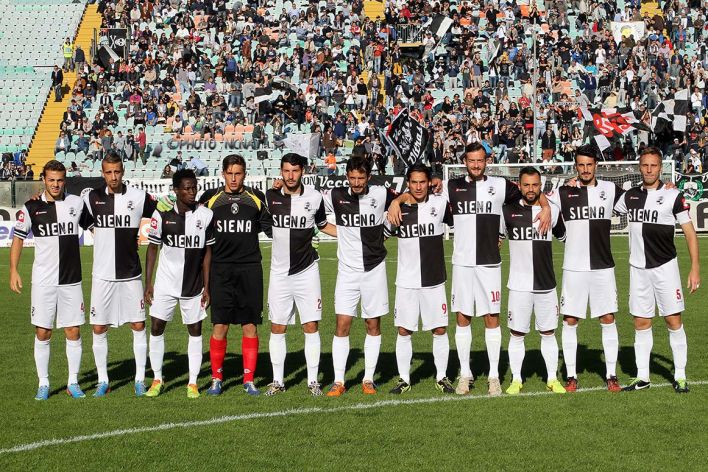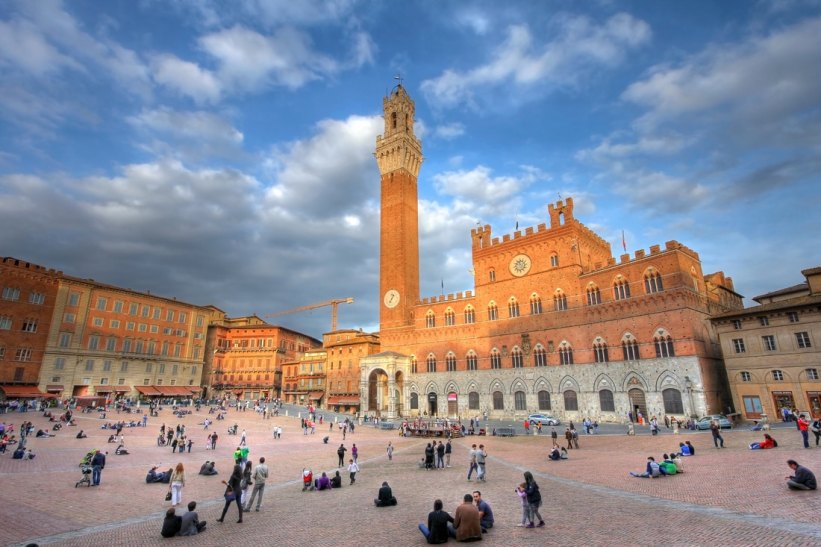We met in Piazza Tolomei, a quaint little square surveyed by a statue of the Capitoline Wolf. The symbol is ubiquitous in Siena, as is the Balzana, the white and black coat of arms adorning walls across the city. From Piazza Tolomei, we moseyed down towards Siena’s hub, Piazza del Campo.
It’s an impressive sight. Upon entering the square, one’s gaze is immediately drawn to the Palazzo Pubblico and its imposing tower, the Torre del Mangia. Viewed from the tower’s peak, the square’s architectural ingenuity is revealed. Its shell-shaped design is encircled by a number of trendy restaurants and bars, some of which boast balconies looking out on the square. One such bar is La Costarella.
“Shall we grab a coffee here?” Marco asked. Having come across my research on the Ultras of his club, he was keen to talk football. We were at the start of October, the late summer air was sultry and Robur Siena’s 2014-15 Serie D season was underway. Marco is a regular on the Curva at Siena’s Stadio Artemio Franchi, however watching his club compete in a non-professional category was a new experience.
Just a few months earlier, AC Siena went bankrupt. It was hardly surprising after the financial bailout of Monte dei Paschi in 2013. The oldest bank in the world is the beating heart of Siena’s economy and its patronage is crucial to the city’s prosperity. Bereft of their patron, the club was drowning. In July 2014, after president Massimo Mezzaroma resigned, nothing could keep them afloat.
But under the guise of Robur, translated as strength and used by supporters to distinguish the club from their basketball cousins, Siena were reborn. Their new title was apt, for while 110-years of history had been preserved, rebuilding from Serie D would require sheer strength of will.
The Toils of Serie D
“We can’t lose to a team like them,” Marco muttered, flicking through the pink pages of the Gazzetta dello Sport. “Playing against Siena at the Franchi is like playing in the Champions League final for their fans, it would be an embarrassment if we lost.”
That Saturday afternoon, the Bianconeri (White and blacks) were hosting Poggibonsi, a team from a small town located just 30 kilometres north of Siena. It was a derby, but of an unfamiliar kind. Just two years before, they had been living the visceral passion of games against virulent rivals Fiorentina in Serie A. But the Robur’s revival had to start somewhere.
As Marco predicted, for Poggibonsi fans the game held particular prestige. Huddled in the Curva Ospiti, a few hundred yellow and red bodies swayed, bounced and chanted during what was a humdrum 0-0 draw. On occasions, the Poggibonsesi attempted to rile their illustrious hosts with chants of ‘Siena Siena Vaffanculo’. But the Senesi in the Curva Robur didn’t deign to respond, instead choosing to insult their historic and ‘worthy’ rivals, Fiorentina.
In reality though, the upstarts from Poggibonsi proved difficult to shrug. They challenged Siena for the Group E, Serie D, title to the bitter end. However the Robur prevailed, securing promotion and the title with a final day victory at Massese. Speaking to Marco immediately afterwards, his relief was palpable. One year on from bankruptcy, Siena had returned to the “football that counts.”
But Serie D had its perks. “In comparison to Serie B and Serie A, the division allowed supporters a lot more freedom. It was like getting to know a new world,” Marco reflected.
“It was more spontaneous. There were huge away days with hundreds of supporters, sometimes thousands. Every Sunday was an invasion, a party for us and for the small towns that hosted La Robur as we packed their restaurants and bars. Amazing support, with drums and flairs. Tickets bought last minute outside the away section. It was a dive into football from the past.”
Yet as the Bianconeri prepare for life in Lega Pro, is it really a case of ben tornato (welcome back) Siena?
Siena: A World of its Own
Piazza del Campo, the beating heart of Siena
The balconies of those trendy bars in Piazza del Campo offer the best view of the oldest horse race in the world, the Palio di Siena. Albeit it would likely cost you in excess of €350.
“Palio è vita” (Palio is life) runs the local phrase. Held twice a year in July and August, this medieval tradition sees ten jockeys race bareback, completing three laps of the Piazza del Campo’s treacherous course. The competitors represent the various Contrade (City Disricts) and the event is both a celebration of the Siena’s rich culture and history, as well as its abiding intra-civic rivalry.
The Senesi live and breathe this event. The passion is raw, as exhibited during the most recent Palio in which a fist fight broke out in the square between two rival Contrade, Torre and Onda.
Unfortunately for Marco, his Contrada – La Chiocciola (The Snail) – did not win the city’s bragging rights. “La Chiocciola had a weak horse and never stood a chance” he lamented, “Selva won. There was a lot of tension in the square which resulted in the fights, but the race itself was a little uneventful.”
Football has hardly been given a moment’s thought. But once the dust on the track has settled, and the drama has subsided, rival Contrade put their differences to one side. Observing Siena’s relationship with the Palio, renowned Italian filmmaker Federico Fellini, concluded: “You people of Siena have a precious thing, and its unique how in the conflict between your districts lies your union.” And what better place to express this unity than the football stadium?
A Long Road Back for La Robur
“The final whistle at Massa [Massese] was a huge relief” Marco confessed. “Promotion [from Serie D] was not easy, but in the end, the joy of winning a championship is always enormous.”
As the squad’s coach pulled into the city, hundreds of exultant Senesi were present to greet them. As is tradition, the team then joined supporters for their triumphant procession through the city centre, the capi ultrá orchestrating proceedings and leading the chants.
“Of course none of this [success] would have been possible without a group of great players and a great Mister [coach] like Massimo Morgia,” Marco admitted. “This man, frank and genuine, was able to create a feel good factor within the city and the supporters.”
Having arrived at the Bianconeri a year ago, Morgia engineered their promotion from Serie D. His passion, old-school philosophy and grounded personality immediately struck a chord with the fans, with whom he conversed on a regular basis. Yet having seemingly put Siena on the road to recovery, Morgia’s contract has not been renewed. This has been exacerbated by the departure of key players, including top scorers Lorenzo Crocetti and Simone Minincleri. The situation left Marco and many Senesi questioning president Antonio Ponte. “The failure to renew Morgia’s contract and that of key players was a move I didn’t like in the slightest. It seems like Antonio Ponte takes things day by day.”
Siena fans have reason to be sceptical, especially when it comes to trusting their owners. The wounds of bankruptcy are yet to fully heal and they cannot forget the guilty parties involved in their demise. At games, insulting chants are still directed at former president Massimo Mezzaroma and Alessandro Profumo, one-time CEO of bank Monte dei Paschi who is now on trial for a tax evasion scheme. It’s a subject on which Marco speaks passionately.
For outsiders, it’s difficult to understand how things work in Siena. The vast sums of money injected into the city by the bank were never used to build a solid sport infrastructure. Just think that Siena have never had a proper training ground, forcing them to use alternative facilities. Instead a ludicrous amount of money (around €10m a year) was channelled into backhanded payments and personal favours within the system. Over the years, Siena’s supporters have been a prominent voice of opposition and denunciation. Following bankruptcy, some hoped this voice would disappear however this hasn’t been the case.
Lega Pro: Back To The Present While Reliving The Past
 Siena’s Ultras show their support in their stronghold, the Curva Robur
Siena’s Ultras show their support in their stronghold, the Curva Robur
While Serie D may have been a dive into the past, Lega Pro will certainly haul the Senesi back to the present. The controversial supporter’s ID card (La Tessera del Tifoso) will once again be required if the fans wish to travel to away games. Furthermore, regulations regarding the use of paraphernalia for choreographies are far more stringent.
“The Tessera is a measure that serves only to distance people from Calcio.” Marco’s view is one mirrored by many supporters across Italy, and the Tessera is often maligned for reducing ticket sales while failing to tackle football-related disorder. “The absence of drums, flares and other materials detracts from the atmosphere however the numbers we take to away games will also depend on the team’s results.”
Enthusiasm will certainly not be lacking when Siena meet the likes of Pisa and Arezzo. These games transcend the average local rivalry, largely due to their historical back-drop. “In Italy, Campanilismo is fierce, perhaps more so in Tuscany than any other region,” Marco opined. He is part of Siena’s younger generation and thus has become accustomed to the rivalry with Fiorentina, also known as the Guelph-Ghibelline derby.
“In Siena we have a strong link with our past, which is still very much alive today. The rivalry with Florence dates back centuries, to the battles and wars fought between the cities from 1200 to the mid-1500s for the supremacy of Tuscany.” This Campanilismo or local pride endures and often reaches its peak within the stadium. “A football match, in this case, represents the means by which you relive the conflicts of the past within the present,” Marco poetically affirmed. And he is expecting equally volatile affairs in Lega Pro. “For me, the most fascinating match will be against Pisa, a team with a great history and large fan base. Let’s just hope we have a team worthy of the occasion.”
Hope of a Robur Renaissance Springs Eternal
Recent developments and transfer activity at Siena has fuelled more optimism among the supporters. Fresh faces have arrived while the team has performed well in a number of pre-season friendlies. Fresh off the back of two uninspiring seasons at Reggina, new coach Gianluca Atzori has a point to prove. The tactician is assembling a competitive squad, including a blend of experienced Serie A veterans such as former Reggina forward Emiliano Bonazzoli and Siena stalwart Daniele Portanova, as well as a number of young loanees.
“In terms of talents to watch out for, 17-year-old defender Daniele Guglielmi has a bright future while in attack we have loaned 18-year-old Kevin Arthur Yamga from Chievo and tre-quartista Marco Piredda from Cagliari.” Marco believes these are all players who could help Siena make the jump in quality. Young goalkeeper Tommaso Biagiotti also has the Senesi excited. Hailing from Siena, the 17-year-old is a boyhood fan of the club and towards the end of last season he saved a crucial penalty, further endearing him to the Artemio Franchi faithful.
During that season, the same faithful would often chant “I dilettanti non ci fa paura, ritorneremmo presto in Serie A” (Playing in non-league football doesn’t faze us, we’ll soon return to Serie A). Of course that is La Robur’s long term goal however Marco is not getting ahead of himself.
“That [Serie A] is what we must be aiming for. Our support is as passionate as any. However to return to Serie B or Serie A, and even better, remain there, we need capable owners and investment.” For Marco, the priority lies with creating a sound infrastructure and investing in the future. Siena need to establish a stable base from which to continue their ascent, however there remain doubts as to whether these goals are achievable under the aegis of the current president.
“The priorities have to be a state of the art training ground, a strong youth section and a new stadium, preferably one that we own. At the moment these are all dreams,” Marco sighed. “We must take inspiration from clubs like Udinese, Atalanta, Empoli and Carpi. It doesn’t matter how many years it takes, if there was a serious project at work, I’d be happy to accept fewer victories.”
With the Lega Pro season due to kick-off on September 6, anticipation is building around the city. The Robur’s revival has got off to the perfect start yet Marco’s expectations remain modest. “I hope we survive comfortably and perhaps win against the likes of Arezzo, Ascoli, Pisa, Ancona, Lucchese and Reggiana. These will be passionate affairs and I hope our team is up to the task.”
Robur Siena are awakening as they prepare to confront historic foes. But they have plenty of battles ahead if they wish to re-establish dominance within Tuscany. For at this present time, returning to Serie A appears anything but black and white.
Grazie mille to Marco for all his expertise and help during my time in Siena, a true Senese!


